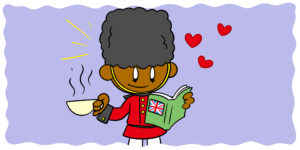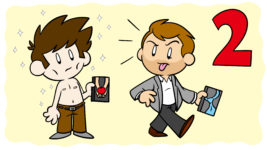Attitudes towards story setting vary to a surprising degree from author to author. Some prefer minimal settings, locating a scene wherever serves the story best and allowing the reader to imagine the details. Some luxuriate in their settings, imagining fascinating vistas, halls, and even worlds at which they hope their readers will marvel. Others fall between the two points, or prefer to be vague except for locations that they feel define the story.
There’s no wrong choice, but there is a price to pay for each of these decisions. Those who don’t describe their settings in enough detail can end up with insufficiently developed worlds, whereas those who spend too long on the details may find their readers have little patience for the scenery.
The key is to know a setting well enough that you can concisely communicate what it’s like without too much description. This can be incredibly difficult, it’s hard to think up every little thing about a place you can only explore in your mind, and many authors opt for a clever way around this problem…
The benefits of a familiar story setting
By setting their story in a familiar place, many authors give themselves the ability to communicate their setting in a way which feels real to the reader.
In Wuthering Heights Emily Brontë uses the moors as a metaphor for the wild emotions of her characters. This means that the setting she describes doesn’t just have to feel real, but has to feel so real that it can also support being used as a reference for complex characterization.
Brontë achieves this fantastically by using a host of real locations to envision her setting, combining locations such as the moor around Haworth, Shibden valley and the countryside near Cowan Bridge (all of which were important locations in her life). Her familiarity with the intricacies of these locations gives her absolute confidence as she describes them, and equips her with minor details that it would be hard to make up:
The abrupt descent of Penistone Crags particularly attracted her notice; especially when the setting sun shone on it and the topmost heights, and the whole extent of landscape besides lay in shadow… You could not climb them, they are too high and steep. In winter the frost is always there before it comes to us; and deep into summer I have found snow under that black hollow on the north-east side!
– Emily Brontë, Wuthering Heights
Likewise, Brontë is able to describe not just the visual or physical aspects of her setting, but to delve into smells, sounds and textures:
Gimmerton chapel bells were still ringing; and the full, mellow flow of the beck in the valley came soothingly on the ear. It was a sweet substitute for the yet absent murmur of the summer foliage, which drowned that music about the Grange when the trees were in leaf. At Wuthering Heights it always sounded on quiet days following a great thaw or a season of steady rain.
– Emily Brontë, Wuthering Heights
These details make the moors real to the reader as a living place. While imagination is infinite, the idea of a setting which changes with the weather in the ways described above is something which springs readily from real experience but would never occur to someone inventing a location from scratch. The river’s sound changing is so subtle, and yet so realistic, that the reader has no choice but to accept Wuthering Heights as a real location.
It’s a mark of Brontë’s skill that she doesn’t stop there, linking these realistic details to the character’s own experiences – not only do we believe the location to be real, but we believe the character’s history within that setting. The reader believes that the speaker found snow in the summer, and so subconsciously accepts that they have had a life outside of the story.
This is the power that a writer can wring from a familiar setting, imbuing every aspect of their story with stolen authenticity. With this in mind it’s easy to understand why an author might choose to set their story somewhere familiar, but as with any narrative choice there are downsides…
Don’t get lost in the mountains
The problem with selecting a familiar setting for a story is that more often than not authors are going to pick somewhere that matters to them. This has the same effect as when authors include their own hobbies or experiences in a story, in that it comes with a blindness as to what the reader will already know, or even find interesting.
Alan Garner’s The Weirdstone of Brisingamen uses Alderley Edge, an area in Cheshire, England, as the setting for his story. While Garner generally uses this real setting to great effect – chase scenes are gripping because the distance to safety is so vividly captured – his own experiences of the area sometimes takes over the narrative:
By Seven Firs and Goldenstone they went, to Stormy Point and Saddlebole… Nell Beck swore she saw them once, but she was said to be mad, and when she died they buried her under a hollow bank near Brindlow Wood in the field that bears her name to this day.
– Alan Garner, The Weirdstone of Brisingamen
Nell Beck was a real woman and a famed ghost of the area, and yet unless the reader knows this the relevance falls by the wayside. Likewise, the locations named at the beginning of the passage are real, and yet without drawing on their particular features the reader encounters them in the same way as any other fantasy location.
In passages such as these Garner falls into the trap of his own love – while the passages will thrill Cheshire locals, the pre-existing knowledge to which Garner appeals is only present in a small fraction of his readership.
While Garner stops here, missing some opportunities but doing no significant harm, this blindness can have a devastating effect on a story. Writers who assume their readers’ interest in a setting will neglect to invite any, and even conscientious authors can miss what makes an area feel real and interesting if they know it too well.
Many authors end up communicating, rather than evoking, feelings about an area – the reader will perceive the story’s awe at a landmark, but won’t feel this emotion themselves. Here a realistic setting can even be distancing; the characters’ intimate understanding of an area chafing against the reader’s lack of personal appreciation.
This is a significant risk when using a real setting, and is a more common outcome than the realism masters like Brontë are able to create. No author can fully appreciate their blind spots, and using a familiar location gives them a lot more opportunities to lose their way.
All is not lost, however, as there’s a simple trick authors can use to distance themselves from familiar locations while retaining those realistic details.
The familiar unknown
While Brontë’s moors were undoubtedly influenced by locations from her life, the actual setting of Wuthering Heights is a fictional amalgam of multiple places. Brontë creates a new setting from the most useful parts of real places, and in so doing creates a place which is unfamiliar enough to keep her on her descriptive toes.
Terry Pratchett is another example of creating a realistic fiction from a real place. His Discworld witches books, such as Witches Abroad and Lords and Ladies, are set in the fictional area of Lancre. Lancre is itself based on the county of Lancashire (once again in England).
Pratchett borrows not just the scenery of Lancashire, but also its mythology and culture. A rural, mountainous place with a sad history of ‘witch trials’ and a proudly stoic culture, Lancashire’s past and present are mixed together in Lancre. Pratchett’s witches are practical, working-class women, Lancre’s landscape is green and wild, and dwarves work under its abundant mountains.
Using Lancashire as inspiration, Pratchett has woven such a fully realized fictional setting that fans can buy A Tourist Guide to Lancre, complete with a detailed map of the area.
Magic glues the Discworld together and a lot of it ends up in Lancre, principal Kingdom of the Ramtop Mountains… The Ramtops supply Discworld with most of its witches and wizards. The leaves on the trees in the Ramtops move even when there is no breeze. Rocks go for a stroll in the evening. Even the land, at times, seems alive.
The mapp may only be two-dimensional, but watch it very carefully and you might see it jostle about a bit.
– Terry Pratchett, A Tourist Guide to Lancre: A Discworld Mapp
In weaving something new out of the most interesting facets of a real place, Pratchett (and Brontë before him) remains constantly aware that the reader is in an unfamiliar place. While Pratchett is free to set stories in the Lancashire terrain, and pick realistic details out to make them believable, he also knows that the reader has no automatic familiarity or interest in the setting – hence locations with names such as Bear Mountain, Brass Neck and Bad Ass (named for a disobedient donkey).
This awareness may prompt an author to better communicate the relevance of an area, or even to make it more interesting with some fictional details, but its chief return is in making the author less comfortable in a familiar place. It’s likely that Brontë’s tale of finding snow is a real event, but even if this is the case she had to know that it was something the reader could use to understand her setting.
Setting off with your story setting
The solution outlined above can lead to amazing settings, allowing incredible realism delivered by an author who is always thinking about the reader. Do remember, however, that bringing the unknown to a familiar place isn’t just a cosmetic change. To truly overcome your biases you’re likely going to have to either combine multiple places or add significant fictional elements to a real location. It’s the intersection of these elements that will get you to ask ‘how would this work?’, and then to fully explain the answer to your reader.
While different authors will reach different conclusions, the best advice I can give on the use of real locations in stories is that, without a sufficient buffer, they are perilous places for even the most self-aware author. That said, with a sufficient sprinkling of the unfamiliar they can be great tools that add otherwise impossible levels of realism to a story.
For those who worry about the line between the two, keep in mind that like any narrative device your skill will increase with practice. Keep trying to write these real/fictional hybrid settings, present them to beta readers, and use their feedback to develop your style. It’s actually one of the areas in which beta readers are most useful, since their understanding and appreciation of your setting will be easy to discuss; if they don’t know why something is supposed to impress them, they’ll ask.
To read more about adding realism to your story check out Are you losing your readers’ suspension of disbelief? Or if you want more on using real locations to inspire your writing, check out Eleven places you can find inspiration for your writing.
How do you choose settings for your story, and how important do you think settings are in your writing? Let me know in the comments.
Many thanks to commenter Richard Bennett, whose questions got me thinking about this subject.






4 thoughts on “Should Authors Use Familiar Places As Story Settings?”
Wonderful article, as always. What do you think about Carver’s realistic locations, Rob?
Hi boostwriter,
Thanks! I think Carver’s settings are drawn with a deft hand, and tend to be about the emotions and experiences connected to those places. I doubt he ‘chose’ settings in the same way many authors will, and because of that you do tend to get the impression that you couldn’t set his stories anywhere else.
Best,
Rob
Is there a specific ratio you’ve found works well for meshing fictional settings with real ones? All I know is, I completely suck at setting descriptions, so if there’s a 60\40 rule or something you think would work best, that would be a big help.
Hi Katherine,
I’m afraid it would depend too much on the variables to give any kind of helpful ratio. What I would advise with setting description is – at least at first – to focus on three aspects of description:
1. The details that need to be there to establish the tone and mood of the scene (the ominous moon above, the gothic arches, the sound of the wind),
2. The details that need to be there because their presence will matter to the plot later (the table the characters sit at, the window they look out of, the flowers they smell),
3. The bare minimum extra information you need to make 1. and 2. feel like they’re happening naturally (for example, if they’re going to notice a mounted animal head that you need to mention for 2., you might want to mention other hunting trophies so that detail feels less staged).
In each case, I do mean ‘need’. If you can accomplish the task without a specific detail, cut it – if it really deserves its place, the absence will jump out at you, and you can reinstate it. A lot of the difficulties authors face around description is that they’re trying to create a specific image when really they need to be giving just enough tone and context for the reader to create their own ideal version. The most comfortable living room or spookiest castle is different for every reader, but that’s fine, because you can persuade them to do most of the work of creating it.
Best,
Rob